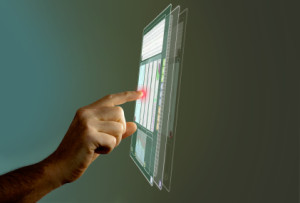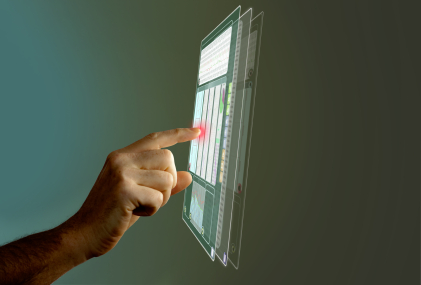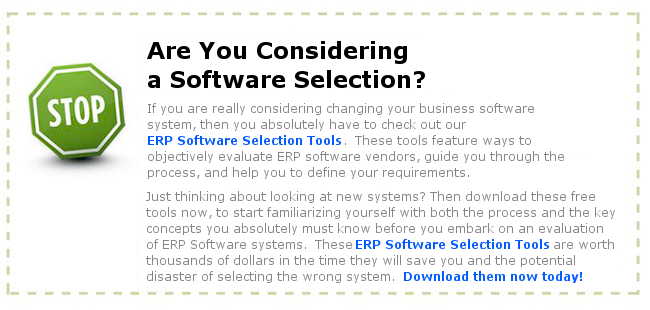When selecting an ERP software solution, you need to be looking at the possibility that your company will be using that system into the future for at least 10 years. In some cases, we’ve seen systems that are 15 to 20 years old. A lot depends upon the industry you are in and the nature of the business leadership. Are they conservative or do they accept new innovation well? In either case, an ERP purchase decision will have a lasting impact on the company. If you are looking to upgrade to new ERP software in the next year, you will likely miss out on some of these new innovations, unless you remain current on all update releases.
Two questions to ponder: What exactly does the future hold for the ERP market and how can you acquire software that will take you into the future? Will you select an ERP that is rooted in the past and will it leave you in the 1990’s?
To help you think about this, here are seven predictions of what will be coming with ERP solutions in the next 10 years:
1. Mobile ERP everywhere
A recent Yahoo Finance Article stated that “The number of smartphones in use in the third quarter of 2012 totaled 1.03 billion, a 47 percent increase from third quarter 2011. Nokia introduced the first smartphone in 1996 and it has taken the smartphone industry 16 years to top the 1 billion mark. By 2015, the research firm predicts that number to double to 2 billion.” Essentially, everyone in the developed world will be on a smartphone. In 2012, Cisco’s CEO stated “…the number of internet connected devices reached 8.7 billion in 2012.” Workforces are becoming more distributed and mobile is the way that you link everyone together.
Because of these staggering numbers, it is clear that the smart device (phones, tablets, watches?) will integrate more and more into what you do both at home and work. Smartphones come with apps…lots of them. Imagine your ERP being run by a smartphone app. No matter if you are on the shop floor, or in a board meeting, you will have access to the ERP data and can transact from your phone. Further, you will have access to tablets. Whether it is a next generation iPad or a Nexus tablet, you will have mobile capabilities to use your ERP software wherever you are.
More amazing is that there is a concept of “smart things” or devices that are smart enough to know about other devices nearby. Near Field Communications (NFC) allows two devices to communicate and transfer data so long as they are within a few inches of each other. This is being put to use in point-of-sale systems and it works a lot like RFID, except that you have two devices communicating with one another instead of just one. This could mean that a shop manager could walk up to a production system with his tablet and immediately, the tablet would show him the job that is being worked, the rate of processing, and the expected end time. It could also show the current work queue along with other data. Further, you could have a parts batch that arrives at a station and based on proximity, it would tell the operator on their tablet the information about the job as well as the devices auto clock-in to the job. RFID does some of this now, but it is going to get a lot smarter and a lot more interactive.
2. ERP Cloud everywhere
Cloud computing is expanding. A recent announcement, such as Oracle and Salesforce to combine clouds, just shows that cloud-based data will be even more accessible. ERP is moving to the cloud. Companies such as Salesforce.com, Netsuite, Kenandy, Intacct, Workday and others are leading that charge.
What about traditional ERP? Yes they too are moving to the cloud, although it may be a hybrid cloud solution. Having a private cloud that seamlessly links you to your legacy ERP data will be the next wave of evolution for traditional ERP vendors such as SAP or Oracle. This two tier solution is already here with the Oracle and Netsuite’s agreement.
ERP will become more distributed. No longer will you have one gargantuan ERP solution. You will take bits and pieces and have standardized interoperability between all the components. Most of which will be in the cloud due to its scalability, its easy deployment, and its connectivity to mobile devices through portals and mobile presentation profiles.
Another advantage of the cloud is frequent updates from the vendor. Quarterly or semi-annual updates to the software are done and you never are bothered. There are no more islands of isolation because you didn’t’ upgrade. You are now current with every other deployment of that ERP Software.
3. Deeper ERP Analytics: the future of ERP mash-ups
With computing power growing to the point exceeding human brain capacity, analytics will be broader and deeper. Obviously, you will be able to mine the corporate data faster and easier. But you will be able to quickly include industry data, supplier data, and other data sources from outside your company in your analysis. Today there is the ability to do “mash-ups” of data. This is more of a web-based technology, but it is going to become part of the day-to-day analytics packages of your ERP solution. To quote the Wikipedia article: “Enterprise mashups are secure, visually rich Web applications that expose actionable information from diverse internal and external information sources.” This is going to be coming to your ERP software solution; native mash-ups of commercially available data.
Additionally, data supplementation will become a standard feature of the new breed of ERP systems. Salesforce is doing that with Data.com. They provide the supplementation of your company and contact data with data acquired from Dun and Bradstreet, with automated cleansing of your data. ERP will move into this space as well.
4. ERP modules as Apps
Following the premise of Apple’s AppStore, enterprise solutions are going to be providing functionality as add-ons that can be leased or purchased from an AppStore. The wonderful thing about on-demand apps is the ability to expand your system as the business requirements dictate, based on thousands of other implementations. Previously, you may have had custom solutions that were unique to your company and you never got to see what other brilliant ideas someone had for expanding the same ERP system. In the near future, you will be able to leverage other’s expansions by way of custom “apps” that will plug in to your instance.
Salesforce is doing this with its AppExchange offering. You have an implementation of Salesforce and you want to extend the functionality or take advantage of predefined functionality that some vendor has provided for their customers, so you go to the AppExchange and quickly download (with a few clicks) that enhancement app to your system. Some are managed and are automatically updated and some are not and will remain as static functionality.
5. Social ERP
Just as Facebook and Twitter have revolutionized how we interact and discuss things, social media is the wave of ERP in the near future. Again, using Salesforce as a model, they rolled out their Chatter product a couple years ago and it has revolutionized the CRM space. Microsoft has acquired Yammer. You can be sure you will see aspects of it in the ERP products such as Microsoft Dynamics NAV or Dynamics GP. What makes social within a business system unique is that you can have a conversation around transactions. Let’s use the example of an ERP. You have a significant work order for your largest client. But there is a parts shortage. People who follow that customer can then see a post – by the system – that there is a problem. A conversation has started. The executive sends an @”manager” message to the line supervisor. He responds to the issue and everyone who is involved with that customer can see what is going on. The @”salesperson” walks into the client’s office for another reason, but beforehand checks the social feed and realizes there is a problem. He lets the customer know that the production is going to take a couple days longer than planned. Because it is early, the client can respond. All of this has just happened in the matter of a few minutes. But it has prevented the typical problems of a late shipment, because everyone involved in the customer account had visibility into the conversation. Pretty amazing!
6. ERP Gamification
Gamification is not as childish as it sounds. Gamification puts incentives on the “players” (aka users) to reach the next level, or accumulate points to earn some reward. Applied to business systems that can mean that users get rewarded based on the amount of transactions they process, or they solve business problems in such a way that they receive awards. Many businesses are likely opposed to gamification simply because the leaders are from a generation not centered on the computer and video games. A key point to consider is: “Generation Y or Gen Y refers to those born from the early 1980?s to the early 2000?s. This generation grew up with video games. They expect immediate feedback and they are willing to take risks and endure ‘epic failure’. They have 10,000+ hours of experience of video gaming experience under their belts.” (from Gamification at Work) The current workforce is programmed around gaming. They are looking for the virtual challenge. Redundant transactions, such as A/P vouchering, are mind numbing to young people who grew up with high velocity gaming on their computer screen. But if you put incentives in the ERP system to accurately complete batches of transactions and you get points that accumulate to prizes, you make the software much more interesting and appealing.
7. ERP Interfaces will change
With the arrival of touch screens and eye scanning, there is a new wave of system design that is focused on the human interaction. The mobile phone is leading this revolution with eye tracking built into the phone that performs certain functions based on how the eyes are moving. Tablets and touch screens have already been mentioned, but they will become as small as sheets of paper.
The interface for an ERP went from punch cards, to green screens, to GUI (graphical user interfaces), to now touch and gestures. These new interfaces will start with the mobile devices as mentioned above, but will soon make their way into standard ERP screens for users. Imagine a purchasing clerk waving her hand at the screen to scroll through open POs. Or, imagine a GL accountant using their finger to scroll through postings. We are moving away from the GUI interface and into touch, gestures, motions and voice interactions with the computer. Developers will come up with new ways to utilize these tools, but they will soon be upon us in the ERP software space.
These are some of the advances we will see coming to the ERP market in the next ten years. There are likely some that will be invented five years from now that we know nothing about, but will be revolutionary. The real question here is how fast current ERP software can move to these new advances. Additionally, how soon will your company upgrade to include these new technologies? The likely answer is not until your next major ERP implementation. Some of the features will roll-out with updates, but more than likely the ERP software you use will not be upgraded for five to seven years from now, depending upon how old it is. So realistically, these new technologies may take up to ten years to become a mainstream part of life. We are interested in hearing your views on the next ten years in the ERP space. What do you think? Comment below and let us know.



